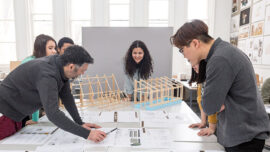
Architecture: An In-Depth Exploration of the Art and Science of Building
Introduction
Architecture is much more than just buildings and structures; it is a fascinating blend of art and science that has shaped human civilization throughout history. From the grand pyramids of ancient Egypt to the soaring skyscrapers of modern cities, architecture reflects the creativity, culture, and technological advancements of each era. In this article, we will delve into the world of architecture, exploring its history, styles, elements, and its significant impact on society.
1. The Origins of Architecture
1.1 Early Architectural Marvels
The dawn of architecture can be traced back to ancient civilizations, where humans built awe-inspiring structures like the Great Wall of China, the Mesopotamian ziggurats, and the Roman Colosseum. These early architectural wonders served various purposes, from defense and religious ceremonies to entertainment and governance.
1.2 Architectural Influences through the Ages
As societies evolved, so did architectural styles. The Greek and Roman civilizations introduced the classical orders, which inspired many Western architectural traditions. The Islamic world brought forth stunning mosques with intricate geometric patterns, while the Far East developed distinct architectural principles seen in temples and palaces.
2. Styles and Movements in Architecture
2.1 Gothic Architecture: Reaching for the Heavens
During the Middle Ages, Gothic architecture emerged, characterized by its pointed arches, ribbed vaults, and flying buttresses. Cathedrals like Notre-Dame de Paris showcased the breathtaking height and intricate stained glass designs of this style.
2.2 Renaissance: The Revival of Classical Beauty
The Renaissance period saw a revival of classical architectural elements from ancient Greece and Rome. Architects such as Michelangelo and Palladio brought balance, proportion, and harmony back into design, resulting in iconic buildings like St. Peter’s Basilica.
2.3 Modernism: Embracing Functionality and Minimalism
The 20th century witnessed the rise of Modernism, emphasizing simplicity and functionality. Pioneers like Le Corbusier and Frank Lloyd Wright championed open floor plans, clean lines, and the use of new materials like glass and steel.
3. The Elements of Architecture
3.1 Form and Function
At the core of architectural design lies the balance between form and function. Buildings must not only be aesthetically pleasing but also practical, catering to the needs of their occupants and purpose.
3.2 Materials and Construction Techniques
The choice of materials, from traditional brick and stone to contemporary composites, plays a vital role in shaping a building’s appearance and longevity. Construction techniques have also evolved with technological advancements, allowing for more sustainable and efficient structures.
3.3 Spatial Planning and Design
Architects carefully plan the layout of spaces within a building to ensure smooth flow and optimal use of space. Creative spatial design can evoke emotions, influence behavior, and enhance the overall experience.
4. The Impact of Architecture on Society
4.1 Creating Identity and Sense of Place
Distinctive architectural landmarks often become symbols of cities and nations, fostering a sense of identity and pride among their inhabitants.
4.2 Sustainable Architecture for a Greener Future
In recent years, architects have embraced sustainable design practices to minimize environmental impact and promote energy efficiency, incorporating green spaces, renewable energy sources, and eco-friendly materials.
4.3 Architecture’s Role in Well-Being
Research shows that well-designed spaces can significantly impact mental and physical well-being. Natural light, ventilation, and access to nature are elements architects consider to create healthier environments.
5. Conclusion
Architecture, the ancient art of building, continues to evolve as human needs and aspirations change. From historical marvels to futuristic eco-friendly designs, it shapes the world we live in and influences how we interact with our surroundings. As we move forward, the fusion of creativity, technology, and sustainability will pave the way for an exciting architectural future.





0 comments
Write a comment